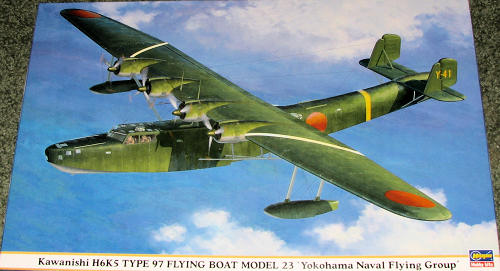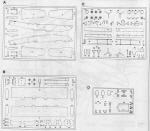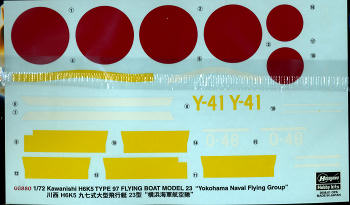
Hasegawa 1/72 H6K5 'Mavis'
| KIT: | Hasegawa 1/72 H6K5 'Mavis' |
| KIT #: | 00880 |
| PRICE: | $ |
| DECALS: | Two options |
| REVIEWER: | Scott Van Aken |
| NOTES: | Reissue |

| HISTORY |
The aircraft was designed in response to a Navy requirement of 1933 and incorporated knowledge gleaned by a Kawanishi team that had visited the Short Brothers factory in the UK, at that time one of the world's leading producers of flying boats. The Type S, as Kawanishi called it, was a large, four-engined monoplane with twin tails, and a hull suspended beneath the parasol wing by a network of struts. Three prototypes were constructed, each one making gradual refinements to the machine's handling both in the water and in the air, and finally fitting more powerful engines. The first of these flew on 14 July 1936 and was originally designated Navy Type 97 Flying Boat, later H6K. Eventually, 217 would be built.
H6Ks were deployed from 1938 onwards, first seeing service in the Sino-Japanese War and in widespread use by the time full-scale war erupted in the Pacific. It had excellent endurance, able to undertake 24-hour patrols, and was even used for long-range raids on Rabaul and the Dutch East Indies.
The aircraft became quickly vulnerable to the new generation of fighters then appearing, but continued in service throughout the war in areas where the risk of interception was low. In front-line service, it was replaced by the Kawanishi H8K.
| THE KIT |
 This
is another reboxing of one of Hasegawa's venerable first generation kits. As one
would expect, the kit has raised panel detailing along with the required rivet
detail, though this is quite subdued. The molds have been well taken care of
though they are showing their age with some flash around several parts. I also
found sink areas on the fuselage and wing. In line with other kits of this
generation, the interior is somewhat simplified, though it does provide seats,
control column, and bulkheads for the cockpit and flight engineer/radio
operator. Three crew figures are also provided.
This
is another reboxing of one of Hasegawa's venerable first generation kits. As one
would expect, the kit has raised panel detailing along with the required rivet
detail, though this is quite subdued. The molds have been well taken care of
though they are showing their age with some flash around several parts. I also
found sink areas on the fuselage and wing. In line with other kits of this
generation, the interior is somewhat simplified, though it does provide seats,
control column, and bulkheads for the cockpit and flight engineer/radio
operator. Three crew figures are also provided.
There are reasonably nice twin row engine representations to fit into the cowling. As befits a kit of this size, the elevators, rudders, and flaps are separate items. Gunners blisters are provided, though there is no additional internal detailing nor any guns for these locales. Beaching gear is given and if one wants to display this aircraft in the water, the mounting holes in the fuselage will need filled.
 Instructions
are well done with the usual Gunze paint references. Rigging diagrams for the
areas that need it are shown and it would be a good idea to do the inner pylon
rigging prior to attaching the upper wing. Markings are for two aircraft, both
shown as Dark Green upper and green lower, though I'm sure this is a misprint
and those areas should be either Light Grey (probably) or unpainted aluminum
(possibly). The first is from the Yokohama Naval Flying Group in the Solomons
during 1942 and is shown on the box art. The Second is from the Toko Naval
Flying Group in the same place during the same time. These differ only in tail
markings and I'm thinking the Toko group does not have the upper wing stripes.
Decals are well printed and should be no problem. They even include the yellow
wing leading edge ID stripes, a real time saver from having to paint them.
Instructions
are well done with the usual Gunze paint references. Rigging diagrams for the
areas that need it are shown and it would be a good idea to do the inner pylon
rigging prior to attaching the upper wing. Markings are for two aircraft, both
shown as Dark Green upper and green lower, though I'm sure this is a misprint
and those areas should be either Light Grey (probably) or unpainted aluminum
(possibly). The first is from the Yokohama Naval Flying Group in the Solomons
during 1942 and is shown on the box art. The Second is from the Toko Naval
Flying Group in the same place during the same time. These differ only in tail
markings and I'm thinking the Toko group does not have the upper wing stripes.
Decals are well printed and should be no problem. They even include the yellow
wing leading edge ID stripes, a real time saver from having to paint them.
| CONCLUSIONS |
This is one of those large aircraft kits that Hasegawa reissues every ten years or so. Despite its age, it is a popular subject and seems to sell out quite quickly. One thing for sure, it makes into a very impressive model and I doubt you'll see this one kitted in this scale by anyone else.
| REFERENCES |
http://en.wikipedia.org
March 2008 Thanks to
http://www.dragonmodelsusa.com for
the preview kit. Get yours at your local shop or ask them to order it for you. If you would like your product reviewed fairly and quickly, please
contact
me or see other details in the
Note to
Contributors.